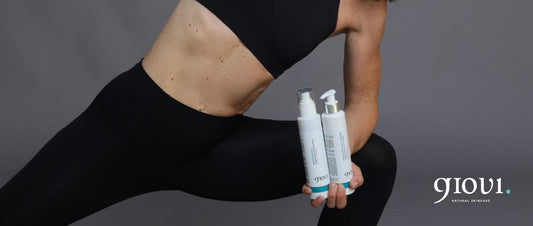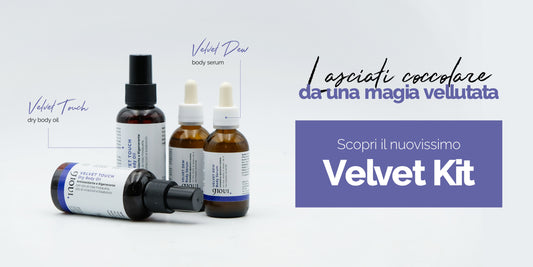It is now clear that our skin is a very important organ, and it is our job to take care of it. By keeping it hydrated and clean we help it carry out its functions correctly and allows us to have a younger and more well-groomed appearance.
In the same way, following a beauty routine suited to our skin, carrying out treatments that are studied and well distributed over time, helps us to keep such an important organ as the skin always healthy.
To understand a little better how cosmetics react in contact with our skin and whether or not they are suitable for the purpose for which they are used, first of all we must understand how our skin is made

The skin is composed of three different layers:
- the outer layer EPIDERMIS
- the intermediate layer DERMA
- the deepest layer HYPODERM
EPIDERMIS
The epidermis is the external layer, at the forefront of our body's defense. It is a stratified squamous epithelial tissue, composed of different types of cells: of Langerans (implicated in the immune response), by Merkel (involved in skin sensitivity), come on melanocytes ( responsible for the production of melanin) and, above all, from keratinocytes, cells specialized in keratin synthesis.
It has no blood vessels and therefore receives nutrition by diffusion from the underlying dermis.
From the inside out, the epidermis is made up of the following layers:
BASAL LAYER or GERMINATIVE LAYER
It is the deepest layer of the epidermis, also called germinative, and is supported by a basement membrane that separates it from the underlying dermis. It consists of a single layer of cubic or cylindrical cells, anchored to the basement membrane by junctions called hemidesmosomes.
The stem cells present in this layer are able to multiply, dividing by mitosis, replacing the superficial skin cells lost or peeled during the day.
The proliferative cells of the basal layer are also flanked by melanocytes and Merkel cells.
THORNY LAYER
It is a thick layer made up of 8-10 layers of polyhedral shaped keratinocytes produced by the underlying basal layer and are connected to each other. thanks to structures called desmosomes. The keratinocytes rise towards the surface, differentiating themselves and taking on from time to time the peculiar characteristics of the layer in which they are found. During migration, the cytoplasm of the cells fills with keratin and its precursors. In addition to keratinocytes, the Langerhans cells, implicated in the immune response, are also found in the stratum spinosum.
The term “thorny” derives from the presence of keratin filaments (similar to spines) anchored to the desmosomes.
GRANULAR LAYER
The stratum granulosum is located under the stratum corneum. It is composed of cells that are already significantly flattened, divided into 3-5 layers, the nucleus of which is in the process of degeneration. The granular appearance of this layer is due to the presence of keratohyalin granules and keratinosomes. The keratinosomes or Odland bodies would contribute to forming the intercorneocyte cement, a substance mainly made up of fatty acids, ceramides and cholesterol, releasing their lamellae in the intercellular spaces, between one corneocyte and another.
Keratohyalin, important for the synthesis of keratin, breaks down into a mixture of amino acids which are at the origin of NMF, a natural hydration factor.
When the granulosa cell loses its capacity for synthesis, the nucleus, membrane and cytoplasm transform into a horny cell (dead cell).
GLOSSY LAYER
It is found only in thick skin (palms of the hand and soles of the feet). It is made up of keratinocytes filled with keratin and tightly adhered to each other, now devoid of nucleus and organelles. Its main function is that of transition between the stratum granulosum and stratum corneum, a gradual passage between a live and a dead layer.
HORN LAYER
The stratum corneum is made up of 15-20 layers of flattened dead cells, rich in keratin and almost devoid of water, called corneocytes. Completely keratinized and containing a very low percentage of water, they are arranged on two layers, a deeper one where the desmosomes are still active and a separate one where flaking due to desquamation begins.
The stratum corneum also contains the pores of the sweat glands and the openings of the sebaceous glands.
The cells of the stratum corneum are bound together by lipids released from Odland's bodies, composed mainly of cholesterol, fatty acids and ceramides. These lipids are essential for the health of the skin, its protective barrier and bind moisture. When lipids are lacking, the skin can become dry and may appear tight and rough.
It's not just dead cells, the main one function of the stratum corneum is to protect the underlying layers and the entire organism from the aggression of external agents (chemical substances, UV rays, mechanical trauma, etc.), but not only that. In fact, the stratum corneum, thanks to the particular structure of the cells that compose it, protects our skin and our organism from dehydration, since, having a certain degree of impermeability, it is able to limit the loss of liquids.
Furthermore, it should be remembered that the stratum corneum is also able to prevent pathogens, such as, for example, bacteria, fungi or other microorganisms from entering the underlying layers (therefore into the bloodstream and, consequently, into the entire organism). .
The epidermis is covered by an emulsion of water and lipids (fats) known ashydrolipidic film.This film, fed by the secretions of the glands sebaceous and sweaty, it helps the skin to remain soft and acts as a further barrier against bacteria and fungi.
DONATION
The dermis is a vascularized and innervated connective tissue composed mainly of collagen, reticular and elastic fibers, fibroplasts and other cell types characteristic of fibrous connective tissue dispersed in the extracellular matrix.
It performs important functions metabolic, immunological, thermoregulatory and sensitive, as well as supportive. At this level we find important structures, such as the sudodiparous and sebaceous glands, the roots and hair bulbs, the hair erector muscles and a dense network of capillaries.
The fibroblasts are the most abundant cells in the dermis and are responsible for the synthesis of ground substance components.
The dermis can be further divided into two layers:
- superficial papillary dermis: contains the blood capillaries and the cutaneous sensory nerve network. In the dermis the fibers produced by fibroplasts are of three types: collagen fibres, elastic and reticular fibres.
- deep reticular dermis: is a dense connective tissue that forms a strong network with structural functions, surrounding blood capillaries, hair follicles, sweat and sebaceous glands as well as nerves.
Inside the dermis we find the Extracellular Matrix, asubstance in which the tissue cells are immersedproduced by fibroplasts which has the primary function to provide structural, functional and protective support.
It is composed of
-
Fibres, in turn composed of proteins which can be distinguished into:
- Collagen: provides structural strength and tensile strength, contributing to the mechanical properties, organization and shape of tissues.
- Elastin: provides elasticity and is largely responsible for the ability of tissues to stretch and shrink.
- Other proteinsthat perform a variety of functions
- Fundamental Substance, it is an amorphous compound composed mainly of water, glycoproteins and proteoglycans to which glycosaminoglycans (e.g. hyaluronic acid) bind which give the skin hydration and lubrication
IPODERMA
The hypodermis allows stabilization of the skin with respect to the underlying tissues and organs such as muscles.
The hypodermis is in fact located between the dermis and the underlying organs. It is commonly known as subcutaneous tissue and is made up of loose connective tissue with abundant fat cells. These cells are made up of massed adipocytes with little fundamental substance and filled with reserve lipids (triglycerides).
The hypodermis is well innervated and vascularized, in fact in the most superficial part it is crossed by veins and arteries, while in the deeper part there are capillaries.
The hypodermis performs the functions of:
- energy store for the organism;
- thermoregulation: acting as an insulator, it offers protection from the cold and protects the body from heat and sweating;
- provides mechanical support, anchoring the upper layers of the skin to the underlying tissues;
- provides mechanical protection against trauma (think of the buttocks when we sit);
- shape the body figure;
- it is vital for the production of vitamin D
The thickness and distribution of hypodermic fat vary depending on body location, nutritional status, sex and age.



